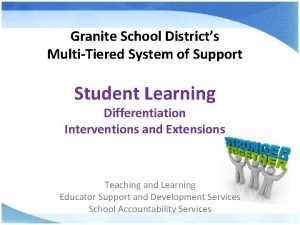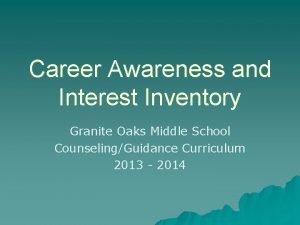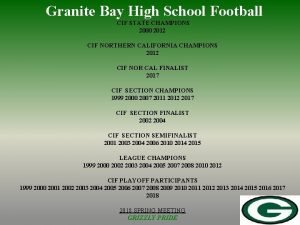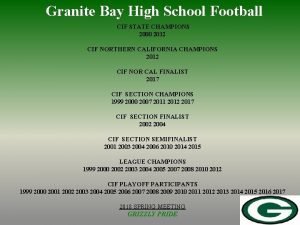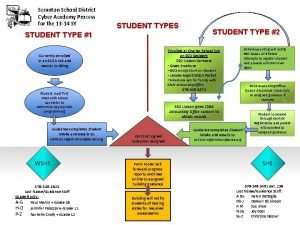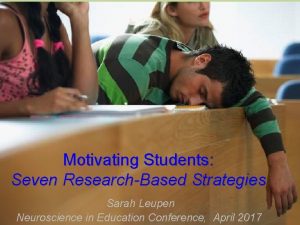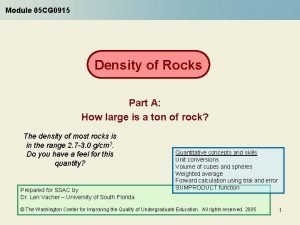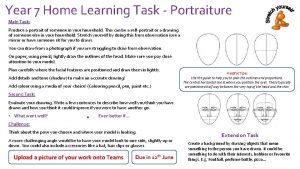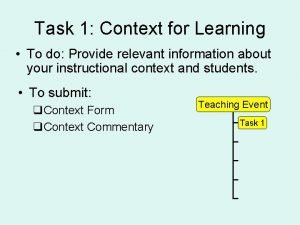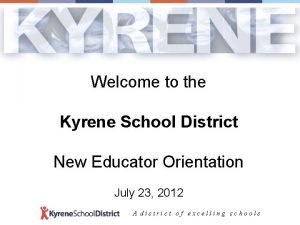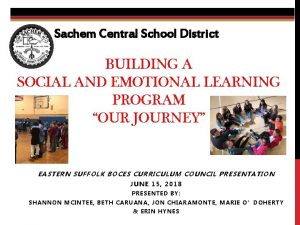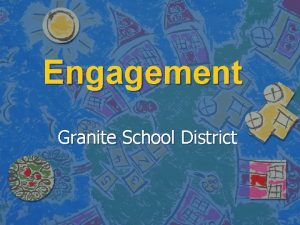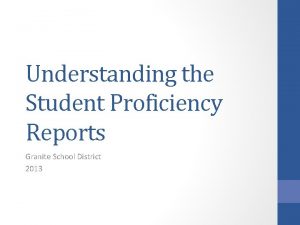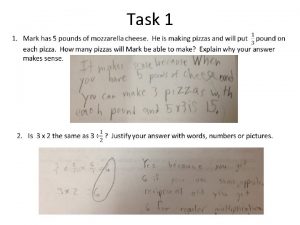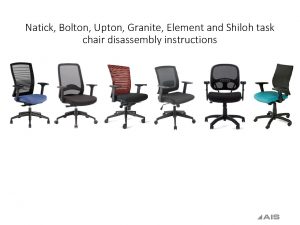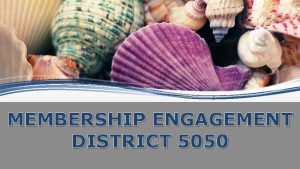Engagement Granite School District Learning Task WarmUp n






























































- Slides: 62

Engagement Granite School District

Learning Task: Warm-Up n Think of a time that you were a student and you were off-task. Were you bored or confused… Why? What was the situation? What was the organization of the class? n Write for three minutes. n Share your story with a partner. n Note the commonalities – one commonality per sticky note.

What do we see? n Bring your common sticky notes to the board. n Note the commonalities.

Ponder at your table … How would this be different in your class? Would this be different in your class?

“Bored” n Do the teachers who “bore” kids really like kids? n Students say they would rather be scared in an out of control classroom than be bored. n Will students who are bored find something else to do?


WE RESERVE THE RIGHT TO REFUSE SERVICE TO ANYONE! (Ever want to put this on your door? )

Let’s Define Direct Instruction Guided Practice Up front, teacher directed, lecture Teacher directed practice (partner or group) Independent Practice When Finished INDEPENDENT practice (seat work) What do I do when done? What is the next task to keep engaged? Fast finishers?

Learning Task: Teacher Habits for Engagement Brainstorm (alone) the various ways you engage students during input, guided practice, and independent practice, and when they’re finished. Use the note-taking guide. But note …

NOTE … “LISTENING” is no longer a verb for you to use when describing what your students will do. Listening is a PASSIVE activity.

How do you know? n Writing n Note n Etc. taking


Learning Task: Teacher Habits for Engagement Brainstorm (alone) the various ways you engage students during input, guided practice, and independent practice, and when they’re finished. Use the note-taking guide. Input Guided Independent Finished (Direct Practice Instruction) Goal

Learning Task: Teacher Habits for Engagement n n Brainstorm (alone) the various ways you engage students during input, guided practice, and independent practice, and when they’re finished. Use the note-taking guide. Share this information with your team. What questions do you have? After examination and discussion of questions, refine your own chart. Write one goal for each area: input, guided practice, … Share one goal with your table.

Direct Instruction – What percentage of students do you want engaged during direct instruction? (benchmark 80%)

Attention Span Age + or – Two minutes!

Direct Instruction – What percentage of students do you want engaged during direct instruction? (benchmark 80%) – How do students signal you that they are ready, finished or need help?

Signals – What percentage of students do you want engaged during direct instruction? (benchmark 80%) – How do students signal you that they are ready, finished or need help? – Why would you want them to know?

Discuss at your table: How do your student signal you that they: are on the page where you want them to be? are ready to go on, need assistance, or finished? What will students do when they get where you want them to be?

Student Engagement vs Student Assessment What is the difference?


Have you felt this way … n It’s not my job to make them learn – it is just my job to present the material. (whose job is it? ) n If you don’t know … ask someone else (what if no one knows? )

Questioning • • • Engagement (90 – 100% Response Rate) Assessment (5% Response Rate) Open (30 – 40% Response Rate) • During Direct Instruction, the teacher uses: 70% ENGAGEMENT Questions 30% ASSESSMENT Questions

Discuss at your table: What percentage of kids in your class respond when you ask an OPEN question? And … who are they?

Is it possible … That during instruction, a student could sit in your class and NEVER answer a question or be called upon… and have it be OK? ?


Assessment (Average: 5% respond) n One student/one response. n Raise of hand – calling on one child. n “Deyanne, who are the main characters? ”


Open Questions (Average: 30 -40% respond) n “Fishing” for an answer” n Students don’t know how to respond. n Question asked usually with no wait time – whoever wants to answer responds. n “Who are the main characters?

Engagement (Average: 90% respond) n Response method given before the question. “Show me (finger count) how many characters are in the story. ” “Whisper to your neighbor the main characters the story. ” n Physical cue to think and then chorally respond.

What percentage of students do you want to be ACTIVELY ENGAGED during Direct Instruction?

So, what is the difference between ACTIVE & PASSIVE?


Ponder … How are you doing when it comes to active engagement during direct instruction?

Name That Question n. Open (1) n. Assessment (2) n. Engagement (3)

Question #1: Who is the main character in the text? Open

Question #2: Tim, what is the answer to number seven? Assessment

Question #3: “Whisper to your neighbor: How did you get your answer to number 5. ” Engagement

Engagement/Questioning Practice Guide n Label each question as open, assessment or engagement. n If it is an open or assessment question, change it to an engagement question or request.

Engage THEN Assess Numbered Heads together – Who was the MOST conflicted character in the story and why? 2. Group Member 3, prepare to answer. 3. Group 7, Member 3 what is your answer? 1.

Assessing for HIGHER Engagement n n n Dice Grid Names on popsicle sticks Hat (randomizer) Selector Tools (Kagan) Other ideas ? ?

“Now is the time that we must choose between what is right and what is easy!” -Albus Dumbledore

Guided Practice n In grade levels, discuss strategies you use to keep students engaged during guided practice. n Share your “best” strategy with the group.

Other ways to keep kids engaged “Responders” Allows you to ask questions, know WHO has responded, and DATA to move forward or to revisit the concept. (apx. $2000 per classroom set)

Other ways to keep kids engaged “Presenters” sleeve with markers ($140/set) (OR use heavy duty sheet protectors) (OR use whiteboards)

Making a lesson more active n Think of a lesson you have taught that may have appeared “boring” or something you do repetitively. n Look at the handout “Active Engagement. ” n Using these samples, “liven” up and add “active engagement” to this lesson. ”

Prepare for a Round Robin: “Mr. Lake will split you into groups of 4”

Round #1 Person #1: write down the equation. Person #2: factor the quadratic. Person #3: solve each factor [set = to 0] Person #4: write the answer in the form of 2 points. Person #1: sketch the graph of the quadratic.

Round #2 Person #2: write down the equation. Person #3: factor the quadratic. Person #4: solve each factor [set = to 0] Person #1: write the answer in the form of 2 points. Person #2: sketch the graph of the quadratic.

Jane Vella “We learn what we are doing. ”

Think Time: n Bring to mind your most difficult class. n On average, are they: actively engaged? somewhat engaged? “ACTIVE” but not at all engaged?

Arrange these strategies from least impact (at top) to greatest impact (at bottom) with respect to their capacity to foster engagement. Average Retention Rates practice by doing discussion group demonstration teach others audio-visual lecture reading

Lecture Engagement Strategies Impact

Lecture Reading Engagement Strategies Impact

Lecture Reading Audio Visual Engagement Strategies Impact

Lecture Reading Audio Visual Demonstration Engagement Strategies Impact

Lecture Reading Audio Visual Demonstration Practice By Doing Engagement Strategies Impact

Lecture Reading Audio Visual Demonstration Practice By Doing Discussion Engagement Strategies Impact

Lecture Reading Audio Visual Demonstration Practice By Doing Discussion Teach Others Engagement Strategies Impact

Engagement Planning Guide Teacher DO Direct Instruction: Guided Practice: Independent Practice: Student DO

House Story

We are here to teach children the behaviors we want to see. Not to crucify them for the behaviors they came with. Geneva Elementary Staff 2000
 Gradebook granite
Gradebook granite Granite teacher support
Granite teacher support Granite student portal
Granite student portal Jones center granite school district
Jones center granite school district Concept learning task in machine learning
Concept learning task in machine learning Granite oaks middle school
Granite oaks middle school Football camp
Football camp Granite bay high school football
Granite bay high school football Warmup ratio
Warmup ratio Warmup 65
Warmup 65 Gmass warmup
Gmass warmup Stratified warmup
Stratified warmup Pyramid warmup
Pyramid warmup Identical rhyme examples
Identical rhyme examples Multiplying exponents
Multiplying exponents Java warmup
Java warmup Define:warmup
Define:warmup Persuasive essay quotes
Persuasive essay quotes Tinman calculator
Tinman calculator Warmup 65
Warmup 65 Warmup end
Warmup end Summer school lodi unified
Summer school lodi unified Iswk uniform
Iswk uniform Scranton school district cyber school
Scranton school district cyber school Tiered task bias task
Tiered task bias task Cuadro comparativo de e-learning b-learning y m-learning
Cuadro comparativo de e-learning b-learning y m-learning Engagement strategies for students
Engagement strategies for students Rhyolite
Rhyolite Basalt and granite
Basalt and granite Granite density
Granite density Metamorphic rocks form from
Metamorphic rocks form from Alkali feldspar granite
Alkali feldspar granite Senior center scottsdale az
Senior center scottsdale az Weathering
Weathering Gradebook granite
Gradebook granite Substance
Substance Serie de bowen
Serie de bowen Economic uses of granite
Economic uses of granite Valvules conniventes asp
Valvules conniventes asp Granite education association
Granite education association Granite classification of matter
Granite classification of matter Granité post hemoptoique
Granité post hemoptoique Formation of soil
Formation of soil Application of trigonometry in navigation
Application of trigonometry in navigation Why is bowen's reaction series important
Why is bowen's reaction series important Rolling stonestone magazine
Rolling stonestone magazine Rolling stone granite
Rolling stone granite Plasterwork imitating granite or marble.
Plasterwork imitating granite or marble. What is a covenant marriage in the bible
What is a covenant marriage in the bible Learning task 2 im an architect
Learning task 2 im an architect Learning task 2 look around your home make a list
Learning task 2 look around your home make a list Learning task 7 create a self portrait
Learning task 7 create a self portrait Learning task 2 musical poem
Learning task 2 musical poem Multi task learning nlp
Multi task learning nlp Context clues learning task 1
Context clues learning task 1 Rod ellis task based learning
Rod ellis task based learning Learning task 1 reflection and refraction
Learning task 1 reflection and refraction Kyrene school district
Kyrene school district Anchorage school district office
Anchorage school district office South kitsap school district skyward
South kitsap school district skyward Cherry hill school district+sfra
Cherry hill school district+sfra Sacramento city unified school district v. rachel h
Sacramento city unified school district v. rachel h Sachem school district reopening plan
Sachem school district reopening plan



